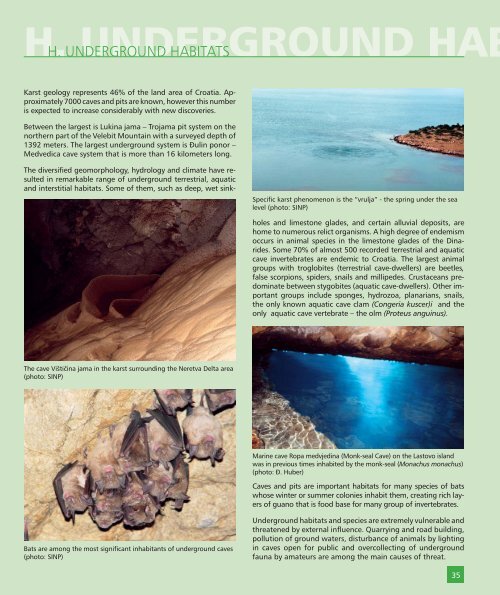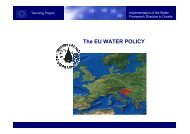BIODIVERSITY OF CROATIA
BIODIVERSITY OF CROATIA
BIODIVERSITY OF CROATIA
Create successful ePaper yourself
Turn your PDF publications into a flip-book with our unique Google optimized e-Paper software.
HAB<br />
H. UNDERGROUND HABITATS<br />
Karst geology represents 46% of the land area of Croatia. Approximately<br />
7000 caves and pits are known, however this number<br />
is expected to increase considerably with new discoveries.<br />
Between the largest is Lukina jama – Trojama pit system on the<br />
northern part of the Velebit Mountain with a surveyed depth of<br />
1392 meters. The largest underground system is \ulin ponor –<br />
Medvedica cave system that is more than 16 kilometers long.<br />
The diversified geomorphology, hydrology and climate have resulted<br />
in remarkable range of underground terrestrial, aquatic<br />
and interstitial habitats. Some of them, such as deep, wet sink-<br />
Specific karst phenomenon is the “vrulja” - the spring under the sea<br />
level (photo: SINP)<br />
holes and limestone glades, and certain alluvial deposits, are<br />
home to numerous relict organisms. A high degree of endemism<br />
occurs in animal species in the limestone glades of the Dinarides.<br />
Some 70% of almost 500 recorded terrestrial and aquatic<br />
cave invertebrates are endemic to Croatia. The largest animal<br />
groups with troglobites (terrestrial cave-dwellers) are beetles,<br />
false scorpions, spiders, snails and millipedes. Crustaceans predominate<br />
between stygobites (aquatic cave-dwellers). Other important<br />
groups include sponges, hydrozoa, planarians, snails,<br />
the only known aquatic cave clam (Congeria kuscer)i and the<br />
only aquatic cave vertebrate – the olm (Proteus anguinus).<br />
The cave Vi{ti~ina jama in the karst surrounding the Neretva Delta area<br />
(photo: SINP)<br />
Marine cave Ropa medvjedina (Monk-seal Cave) on the Lastovo island<br />
was in previous times inhabited by the monk-seal (Monachus monachus)<br />
(photo: \. Huber)<br />
Caves and pits are important habitats for many species of bats<br />
whose winter or summer colonies inhabit them, creating rich layers<br />
of guano that is food base for many group of invertebrates.<br />
Bats are among the most significant inhabitants of underground caves<br />
(photo: SINP)<br />
Underground habitats and species are extremely vulnerable and<br />
threatened by external influence. Quarrying and road building,<br />
pollution of ground waters, disturbance of animals by lighting<br />
in caves open for public and overcollecting of underground<br />
fauna by amateurs are among the main causes of threat.<br />
35









